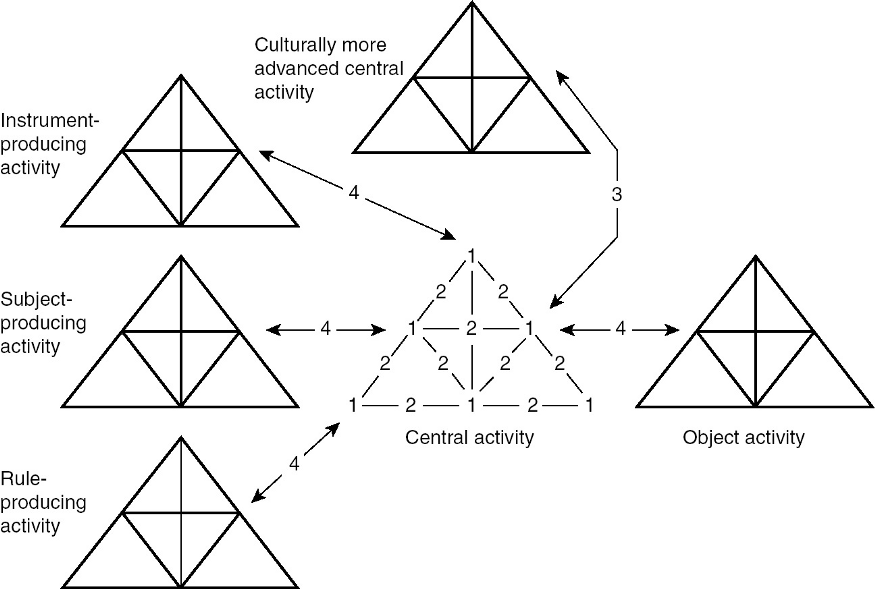Activity System: Four levels of contradictions [Activity Theory]
![Activity System: Four levels of contradictions [Activity Theory]](https://images.unsplash.com/photo-1469571486292-0ba58a3f068b?crop=entropy&cs=tinysrgb&fit=max&fm=jpg&ixid=MnwxMTc3M3wwfDF8c2VhcmNofDl8fHRlYW18ZW58MHx8fHwxNjM0MTY2MzA3&ixlib=rb-1.2.1&q=80&w=960)
A key concept of activity theory is “contradictions”. Engeström also used this concept to guide the notion of “expansion”. He said, “Within the structure of any specific productive activity, the contradiction is renewed as the clash between individual actions and the total activity system…The fundamental contradiction arises out of the division of labor…The two directions or ‘opposite starting points’, from within an activity and from between two activities, are essential for the emerging concept of expansion…”(1987, pp.98-99)
The concept of “contradictions” can be applied to different levels of analysis. For example, it can be used to discuss contradictions within one activity or contradictions between two activities. It also can be used for analyzing high-level abstract “human activity system” such as “subject-producing activity”, or everyday life concrete “activity” such as “school bus activity”.

Engeström used the above diagram to discuss four levels of contradictions within the human activity system at the abstract high level:
Level 1
Primary inner contradiction (double nature) within each constituent component of the central activity.
Level 2
Secondary contradictions between the constituents of the central activity.
Level 3
The tertiary contradiction between the object/motive of the dominant form of the central activity and the object/motive of a culturally more advanced form of the central activity.
Level 4
Quaternary contradictions between the central activity and its neighbor activities.
Why did Engeström talk about it?
He claimed that “the concept of learning activity can only be constructed through a historical analysis of the inner contradictions of the presently dominant forms of societally organized human learning.” (1987, p.106)
He said, “The original forms of human learning are those where learning appears predominantly as an unintentional and inseparable aspect of the basic work activity (Alt 1975; Wilhelmer 1979). In terms of activity theory, this kind of incidental learning consists of nonconscious learning operations, embedded in the daily participation in joint work.”
Levels of Activity and Disruptions
Activity Theorist Clay Spinuzzi’s 2013 book Topsight: A guide to studying, diagnosing, and fixing information flow in organization introduces a methodology for researching work activities with Activity Theory.

The above chart is the summary of analytical models for Topsight. Based on the three-level hierarchy of Activity Theory, Topsight suggests the following three levels of activity:
- Macro (organization) level: culture and history; objectives and outcomes.
- Meso (human) level: actions and goals.
- Micro (habit) level: habits and reactions.
In fact, there are two models at the Macro level: Activity Systems and Activity Networks. Since the basic unit of Activity Networks is an Activity System, we can also consider it as a four-level hierarchy.
For Topsight, the most important theme is Understanding Disruptions. According to Clay Spinuzzi, “If you’ve carefully collected data, you can find patterns to people’s work, including patterns in their mistakes and difficulties. That’s because work is generally set up in cycles and managed with relatively stable information resources and work patterns. Because that’s the case, even mistakes and difficulties tend to cluster around specific parts of the work. Let’s call those mistakes disruptions. Disruptions happen at different levels: macro, meso, and micro levels.” (2013, p.165–166)
Each level has its own type of disruptions:
- Micro level: Breakdowns
- Meso level: Discoordinations
- Macro level: Contradictions
This hierarchy is awesome! Since we have a model of the hierarchy of activity, we can assign problems to different levels which require different solutions.
Systemic Contradictions and Design
Dr. Frederick van Amstel is a design educator and researcher who adopts Activity Theory for design research. His PhD thesis Expansive design: designing with contradictions focuses on the concept of Contradiction for discussing the relationship between activity and space.

According to Van Amstel, "Design activity is a professional occupation that interacts with other activities, whereas design space is a range of possibilities considered for a project. The contradictions in both sides are separately identified and then rejoined to follow the transitions from one side to another."
Van Amstel uses the painting Treachery of Images (1929) by René Magritte as a classic example of contradiction of representation, "It is not a pipe because it is an image of a pipe. With the intense reproduction of this artwork, the critical message expressed by the title was lost and the image is now used to illustrate linguistic and semiotic choices. Now the image became a pipe."

Design runs the risk of doing something similar to change. If change is reduced to a watered-down, smooth process of technical problem-solving, then change will become an image that can be consumed by individuals as well as by organizations. This simulation will never deliver real change since this would undermine “future sales”. It is change for change’s sake, a meaningless thing that just looks like a meaningful thing.
Van Amstel is working on developing a new "design thinking" called Dialectical Design for dealing with systemic contradictions in design activities.
